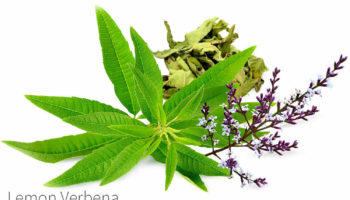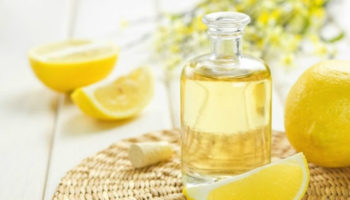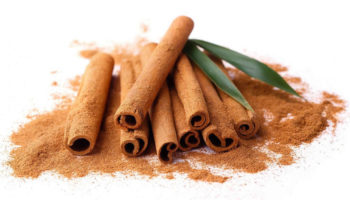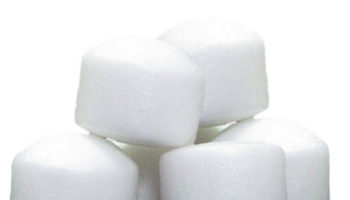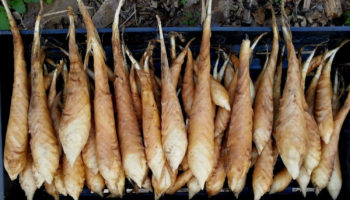What is cordyceps sinensis mushroom
Cordyceps is the composite of a genus of fungus of Ascomycete fungi (sac fungi) that grows on the larva of insects 1. To date, more than 350 Cordyceps-related species have been found worldwide based on fungus and/or insect host. However, since 1964, only Cordyceps sinensis has been recorded officially as an herbal drug in Chinese pharmacopoeia 1.
Figure 1. Cordyceps growing in dead insect body
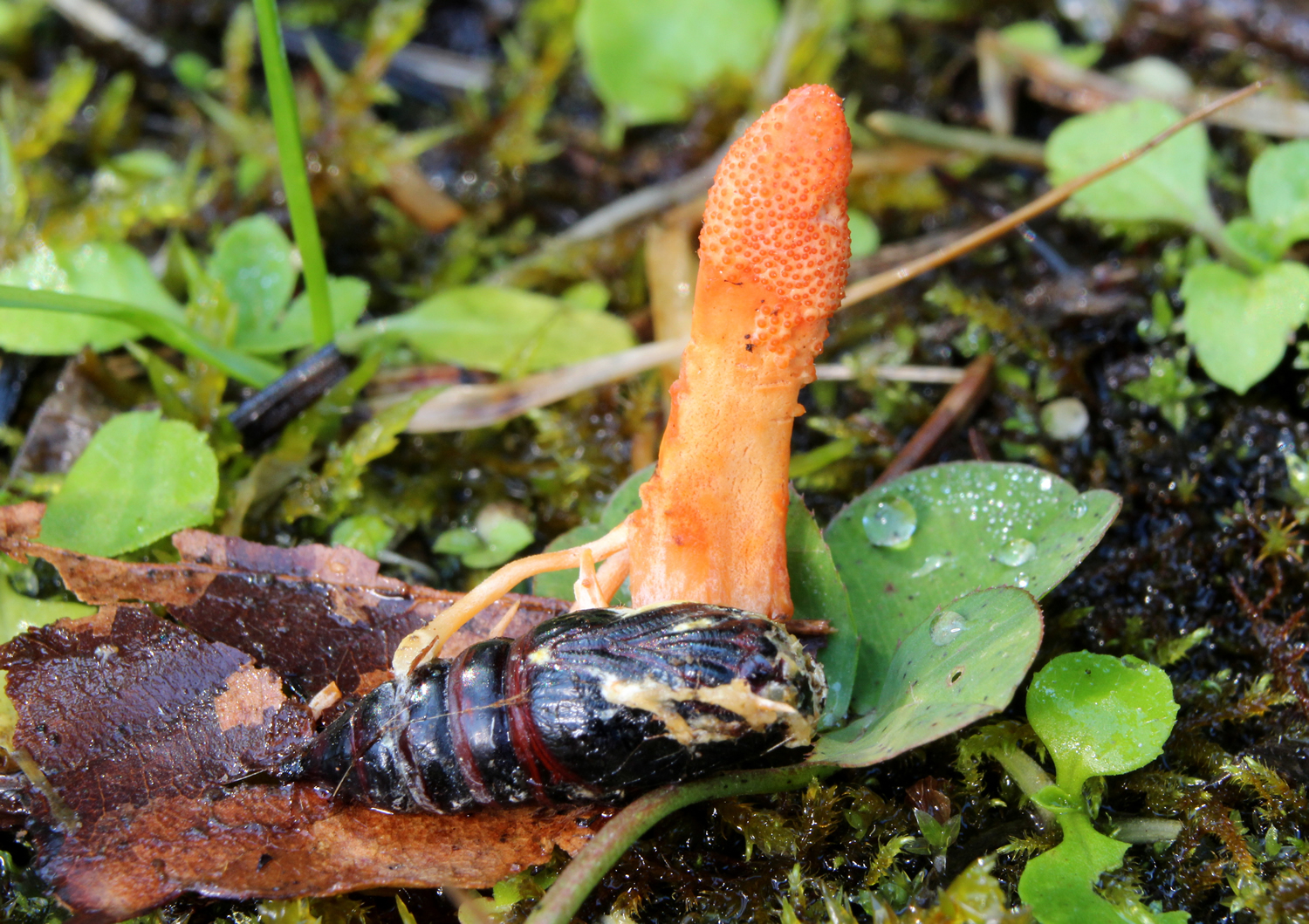
Note: The cordyceps fungi infects insects, and slowly kills the organism. Once the insect is dead, the fungi continue to grow until the body of the fungi grows out of the insects’ head or body and releases more spores to attack other insects.
Cordyceps Sinensis also known as Dongchongxiacao (winter-worm summer-grass) in Chinese, is one of the most famous traditional Chinese medicines and medicinal mushrooms. The fungus attacks the larva of some species of insects (Fam. Hepialidae), and converts each larva to a sclerotium, from which the fruiting body grows 1. The name cordyceps comes from Latin words meaning club and head. The mycological features, related species and vernacular names are given in Table 1. According to the theory of Chinese medicine, Cordyceps sinensis is sweet in taste and neutral in nature, and it can replenish the kidney, soothe the lung, stop bleeding, and eliminate phlegm. The fungus Cordyceps sinensis has been used for the treatment of fatigue, cough, hyposexuality, asthenia after severe illness, renal dysfunction, and renal failure 2. In China, Cordyceps Sinensis is found in the soil of prairies at elevations of 3500–5000 m, in cold, grassy, alpine meadows mainly in the provinces of Qinghai, Tibet, Sichuan, Yunnan, Gansu and the Himalayan mountains. In China, Cordyceps sinensis has been known and used as a remedy for more than 300 years.
The normal harvesting period stretches from April to August. The fungus is parasitic in nature. The base of the mushroom first originates from an insect larval host (Hepialis armoricanus family Hepialidac) and ends at the club-like cap, including the stipe and stroma. The fruit body is dark brown to black, and the root of organism, the larval body pervaded by the mycelium, is yellowish to brown color 3. The immature larvae (host) on which cordyceps grows usually lies about 6 inches below the surface of the ground. As the fungus approaches maturity, it consumes more than 90% of the infected insect effectively mummifying its host. As the stroma matures, it swells up and develops perihelia. The average weight of cordyceps is about 300–500 mg.
Table 1. Mycological features and vernacular names of Cordyceps sinensis
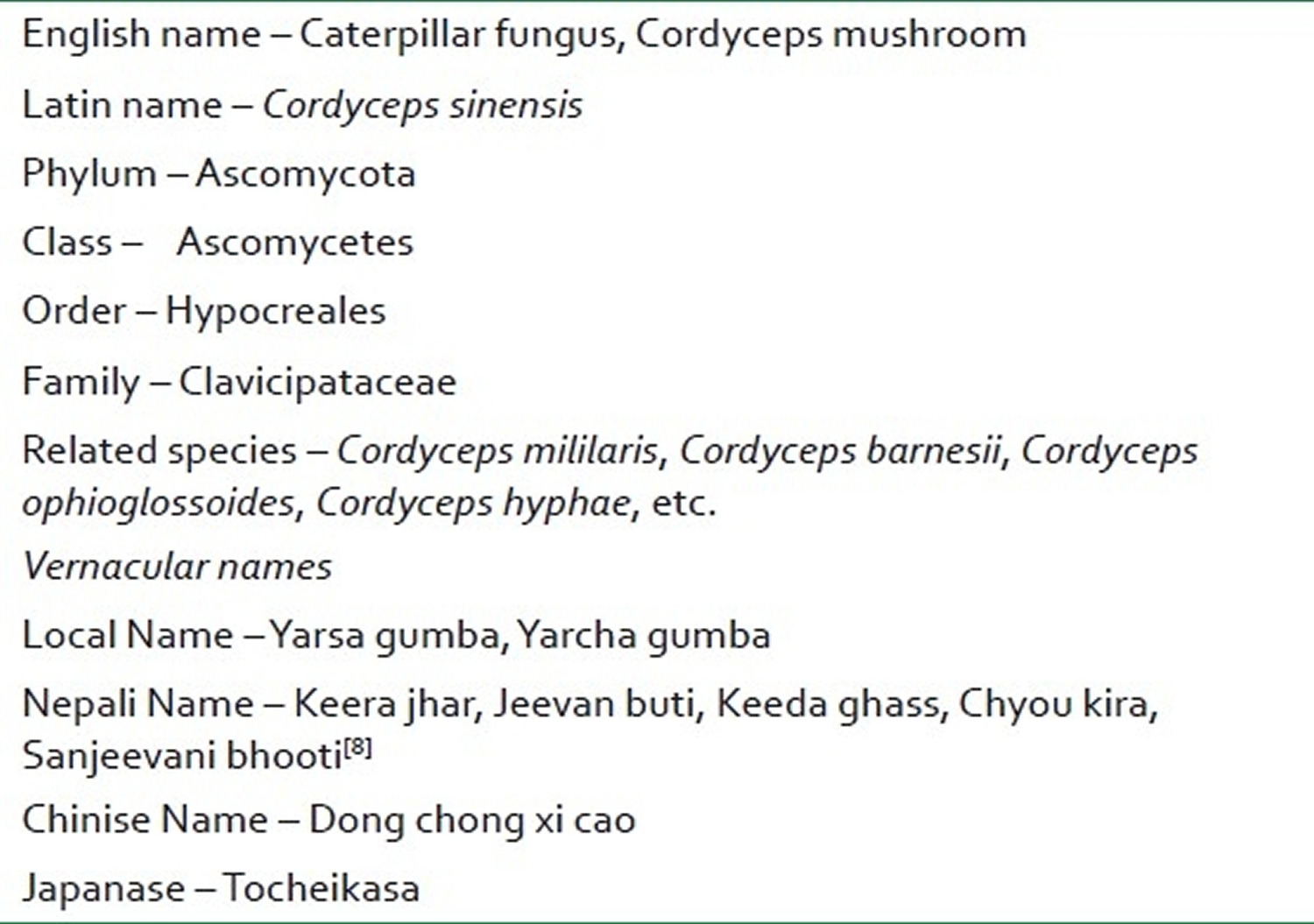
Initially local herders observed that yak, goat, sheep, etc. consuming Cordyceps Sinensis during their grazing in the forest became very strong and stout. This observation paved the way for the discovery of its medicinal value. Thereafter, local people and herders used the fungus powder with jaggery to increase milk production, and improve reproductive capacity and vitality of their cattle. Then its relevant medicinal properties were explored, collecting only the aerial part (fruiting body/stroma), which they dried in sunlight as primary processing. Then they themselves consumed it and became convinced of its medicinal effects in enhancing vigor and vitality. They further claimed that it has aphrodisiac effects, and hence they used to give it as a gift to relatives and friends.
At present, local folk practitioners use the product alone or in combination with other medicinal herbs to treat various diseases, administering different doses for different ailments according to their experience, based on an empirical trial-and-error method. People of both sexes usually take one piece of Cordyceps Sinensis with a cup of milk to enhance their sexual potency and desire. The Bhutia community put one piece of Cordyceps Sinensis in a cup of local-made alcohol (chang), leave it for 1 hour, and drink it morning and evening as a tonic. Some use hot water instead of alcohol. Some folk healers use Cordyceps Sinensis for diabetes and other wasting diseases. It is used for cancer mixed with texus leaf and Ginseng root decoction. Similar reports are also available from Nepal 5, 6. An attempt was made to evaluate the strength of the folk claims by counting the number of users for particular illnesses. Prolonged, continuous use by local folk healers/traditional healers for the treatment of 21 ailments, including cancer, bronchial asthma, bronchitis, tuberculosis, diabetes, cough and cold, erectile dysfunction, benign prostatic hyperplasia, jaundice, alcoholic hepatitis, etc., were noted [Table 2]. Most traditional healers and elderly people use it to increase longevity and cure erectile dysfunction 7.
Table 2. Traditional uses of Cordyceps sinensis (Yercha gumpa)
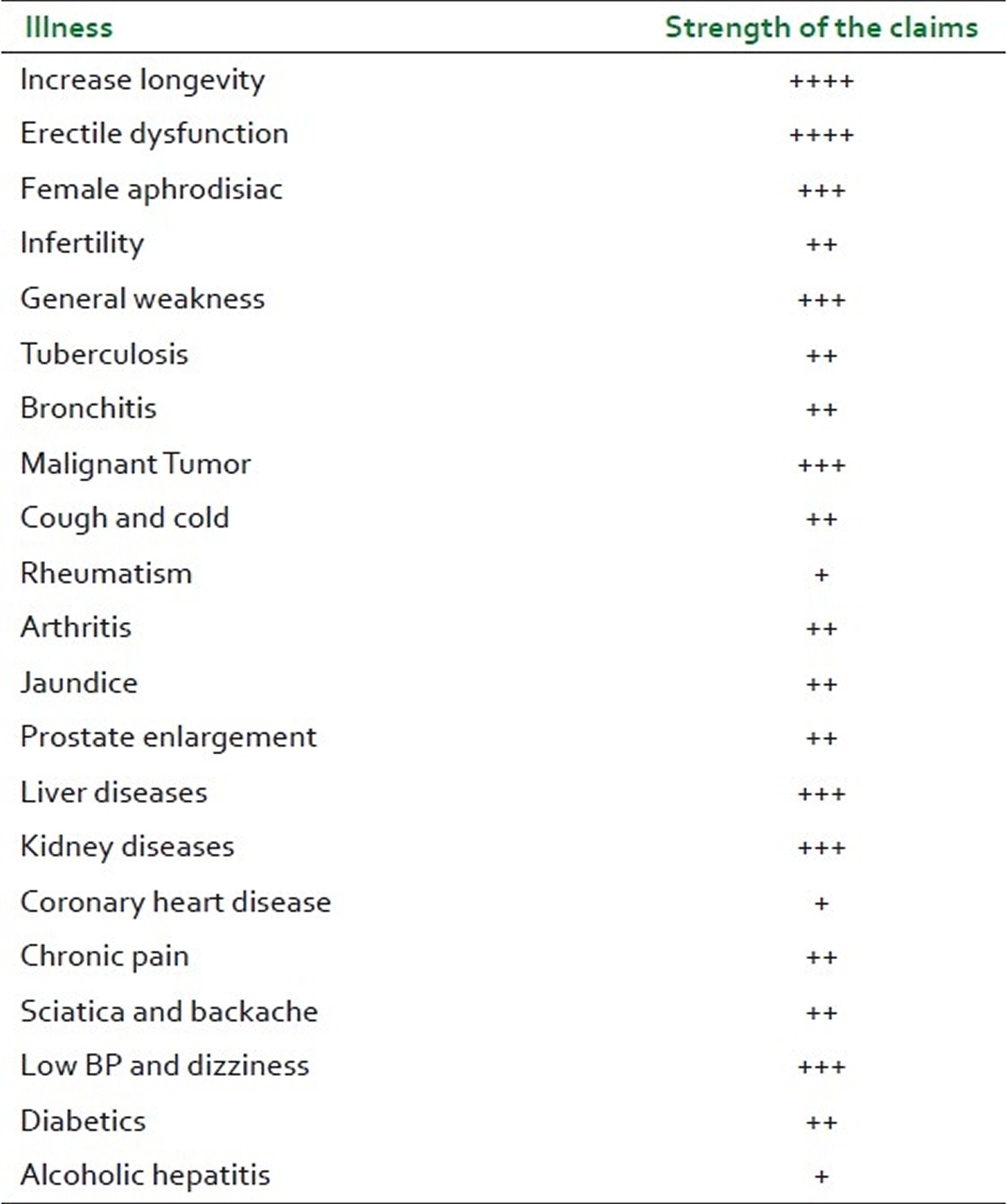
Due to the rarity and outstanding curative effects of Cordyceps sinensis, some natural substitutes such as Cordyceps militaris, Cordyceps liangshanensis, Cordyceps gunnii, and Cordyceps cicadicola have been sold in markets 8. In addition, several cultured mycelia of C. sinensis and C. militaris fungi have become the main substitutes of the natural species as commercial products, and 50 medicines and two dietary supplements related to cultured Cordyceps have been approved by the State Food and Drug Administration of China since 2002 9. For example, JinShuiBao capsule, the commercial product of Cs-4 (Paecilomyces hepialid, a standardized mycelium of C. sinensis), has been used in clinics throughout China. This product generates several million U.S. dollars every year. Synnematum sinensis, Cephalosporium sinensis, Gliocladium roseum, and Mortierella hepialid, the fungus strains isolated from natural Cordyceps sinensis, have also been subjected to large- scale fermentation and are used as commercial products 10. Therefore, much effort has been invested in studying the evaluation of the quality, pharmacological activities, and clinical efficacies of natural and cultured cordyceps. In this chapter, we focus on the bioactivities, action mechanisms, and active ingredients of cordyceps, both natural and cultured.
Cordyceps benefits
Cordyceps has a long history of use as a lung and kidney tonic, and for the treatment of chronic bronchitis, asthma, tuberculosis and other diseases of the respiratory system. The cardiovascular effects of Cordyceps are being noticed more frequently by researchers as it works through variety of possible ways either by lowering high blood pressure via direct dilatory effects or mediated through M-cholinergic receptors resulting in improvement in the coronary and cerebral blood circulation 11. Thus, Cordyceps has implications at the therapeutic level as well by rectifying the abnormalities in rhythmic contractions (also known as cardiac arrhythmia). Cordyceps extract has also been found as a promising source to increase cardiac output up to 60 % in augmentation with conventional treatment of chronic heart failure 12. The product from wild type and cultured Cordyceps has also been shown to significantly decrease blood viscosity and fibrinogen levels preventing myocardial infarction 11. Another study showed that the fermentation products of Cs-4 reduce myocardial oxygen consumption in animals under experimental lab conditions revealing dramatic anti-anoxic effects 13. These studies provide strong evidence that Cs-4 and its fermentative solution prevent platelet aggregation stimulated by collagen or adenosine di-phosphate. An intravenous injection of concentrated Cordyceps extract (90 μg/kg per min, i.v.) resulted in 51–71 % reduction in 51Cr-labeled platelet aggregation in the endothelial abdominal aorta in rabbit 11.
Table 3. Bioactive compounds isolated from Cordyceps sp.
| S. no | Bioactive compounds | References |
|---|---|---|
| 1 | Cordycepin | Cunningham et al. 14 |
| 3 | N-acetylgalactosamine | Kawaguchi et al. 15 |
| 4 | Adenosine | Guo et al. 16 |
| 5 | Ergosterol and ergosteryl esters | Yuan et al. 17 |
| 6 | Bioxanthracenes | Isaka et al. 18 |
| 7 | Hypoxanthine | Huang et al. 19 |
| 8 | Acid deoxyribonuclease | Ye et al. 20 |
| 9 | Polysaccharide and exopolysaccharide | Yan et al. 21 |
| 10 | Chitinase | Lee and Min 22 |
| 11 | Macrolides (C10H14O4) | Rukachaisirikul et al. 23 |
| 12 | Cicadapeptins and myriocin | Krasnoff et al. 24 |
| 13 | Superoxide dismutase | Wanga et al. 25 |
| 14 | Protease | Hattori et al. 26 |
| 15 | Naphthaquinone | Unagul et al. 27 |
| 16 | Cordyheptapeptide | Rukachaisirikul et al. 28 |
| 17 | Dipicolinic acid | Watanabe et al. 29 |
| 18 | Fibrynolytical enzyme | Kim et al. 30 |
| 19 | Lectin | Jung et al. 31 |
| 20 | Cordymin | Wonga et al. 32 |
Table 4. Major pharmacological functions of Cordyceps sinensis
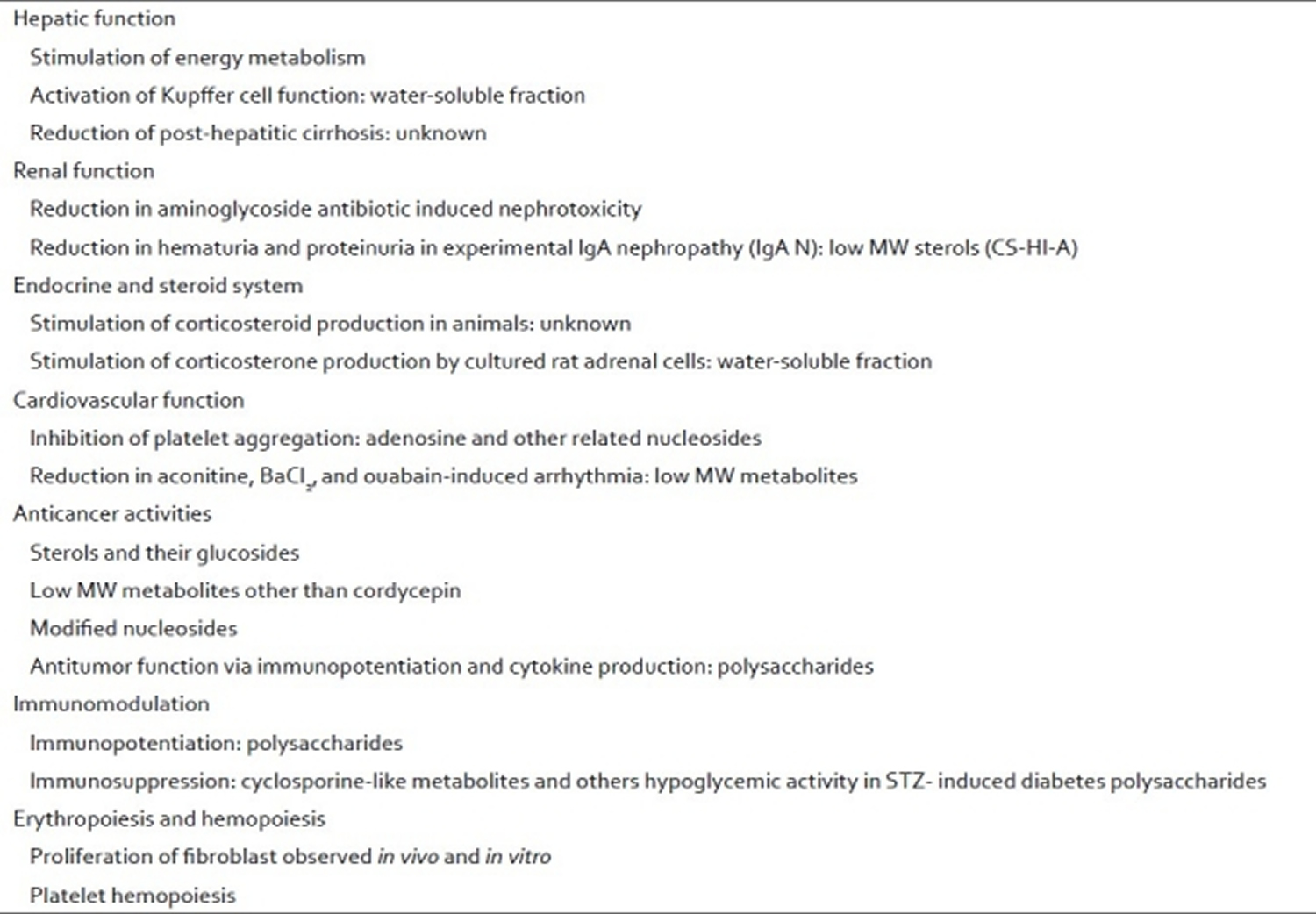
Studies have also shown that cordyceps has antitumor activity in various cancers through several pathways. Both natural and cultured cordyceps have demonstrated antitumor effects 9, 35.
Studies in the laboratory involving animals showed cordyceps had an inhibitory effect on Ehrlich ascites carcinoma and meth-A fibrosarcoma 36, EL-4 lymphoma 37, B16 melanoma 38, Lewis lung carcinoma 39, and H22 tumors 40 in mice. Furthermore, Cordyceps sinensis reversed the suppressive effect of Taxol-induced leukopenia in mice, which indicated that Cordyceps sinensis could be used with other chemotherapy methods for cancer treatment 41. Cordyceps exhibited direct cytotoxic activity against several kinds of tumor cells, including Lewis lung carcinoma, B16 melanoma, lymphocytic (Jurkat), prostate (PC3), breast (MCF7), hepatocellular (HepG2, Hep3B), colorectal (HT-29)and HCT 116), and HL-60 cells 39, 36, 42, 39. Although cordyceps had a cytotoxic effect on tumor cells, it did not show any cytotoxicity against normal cells 42.
Several mechanisms contribute to the antitumor effect of cordyceps, such as direct cytotoxicity, immunopotentiation, apoptosis, selective inhibition of ribonucleic acid (RNA), and protein synthesis, as well as antioxidant, antiangiogenic, antimutagenic, antimetastatic, and antiviral activities 43, 44, 35. Of them, the apoptotic homeostasis regulated by cordyceps might be the most important 44 mechanism. The apoptotic molecular mechanism of cordyceps includes the activation of Bax, caspase-3 and/or -9, -8; inhibition of cyclooxygenase-2 (COX-2); and nuclear factor κB (NF-κB) protein expression and downregulation of Bcl-2 level 44. Besides, apoptosis of MDA-MB-231 human breast carcinoma cells induced by C. militaris aqueous extract (0.8 mg/mL) was also associated with loss of mitochondrial membrane permeability. In addition, the extract decreased Akt activation and reversed PI3K/Akt-pathway-enhanced apoptosis 45. Furthermore, the apoptotic events induced by the extract were also mediated by diminished telomerase activity 46.
Cordyceps side effects
Some reports are published on its adverse gastrointestinal behaviors like dry mouth, nausea and diarrhea 47. In some patients, allergic response has been seen during treatment with a strain of Cordyceps, i.e., CS-4 48. Patients, who suffer from autoimmune diseases such as rheumatoid arthritis, systemic lupus erythematosus and multiple sclerosis, are generally suggested to avoid its use. Reports are still lacking on pregnant and lactating women but some animal studies in mice have revealed that Cordyceps have effects on plasma testosterone levels 49, 50. There has been couple of reports on lead poisoning in patients taking Cordyceps herbal medicine for treatment. The lead content in the Cordyceps powder in these cases was significantly high (20,000 ppm) 51. However, the blood lead levels returned to normal upon termination of the product consumption.
Besides few negatively published data, Cordyceps is relatively considered to be a non-toxic medicinal mushroom. Cordyceps dose in patients suffering from long-term renal failure was demonstrated up to 3–6 g/day 11. In clinical studies involving lung cancer, chemotherapy was carried out with the combination of Cordyceps 52. In another clinical trial, results of Cordyceps (3.15 g for 5 weeks) were compared with placebo to evaluate its effects on physical performance 53. In general, researchers demonstrated that 3–4.5 g of Cordyceps/day is sufficient except in patients suffering from severe liver disease 54. However, no human toxicity report was found and even animal models were failed to determine median lethal dose. Cordyceps dosage up to 80 g/kg body weight/day for 7 days was injected intraperitonealy in mice and even then it did not cause any fatality 55. In another study, rabbits fed through mouth for 3 months at a dose of 10 g/kg/day did not show any deviancy in blood reports, or in kidney, liver functioning 56. Even water extract of Cordyceps sinensis was found to be non-toxic on macrophage cells line RAW264.7 proliferation 57. It is suggested that caution should be taken while taking Cordyceps by patients who are undergoing anti-viral or diabetic drug treatments as Cordyceps contains hypoglycemic and anti-viral agents, which can further affect the dosage of these drugs 58.
Summary
Cordyceps sinensis is a valued traditional Chinese medicine. Experiments in test tubes and in animals have shown that cordyceps has several bioactivities, such as antitumor, immunomodulatory, antioxidant, sexual and reproductive function enhancement, hypoglycemic, and antifatigue activities, and have a protective effect on the kidney and liver. However for it to be a truly useful for human, Cordyceps need to be studied further in well designed clinical trials.
- Lin B, Li S. Cordyceps as an Herbal Drug. In: Benzie IFF, Wachtel-Galor S, editors. Herbal Medicine: Biomolecular and Clinical Aspects. 2nd edition. Boca Raton (FL): CRC Press/Taylor & Francis; 2011. Chapter 5. Available from: https://www.ncbi.nlm.nih.gov/books/NBK92758/[↩][↩][↩]
- State Pharmacopoeia Commission of PRC. Pharmacopoeia of the People’s Republic of China. Vol.1. Beijing: Chemical Industry Publishing House; 2005.[↩]
- Kinjo N, Zang M. Morphological and phylogenetic studies on coryceps Sinensis. Mycoscience. 2001;42:567–74.[↩]
- Panda AK, Swain KC. Traditional uses and medicinal potential of Cordyceps sinensis of Sikkim. Journal of Ayurveda and Integrative Medicine. 2011;2(1):9-13. doi:10.4103/0975-9476.78183. https://www.ncbi.nlm.nih.gov/pmc/articles/PMC3121254/[↩][↩]
- Devokota S. Yarsagumba [Cordyceps sinensis (Berk.) Sacc.] Traditional utilization in Dolpa district. West Nepal. Our Nat. 2006;4:48–52.[↩]
- Adhikari MK, Devkota S, Tiwari RD. Ethnomycolgical Knowledge on Uses of Wild Mushrooms in Western and Central Nepal. Our Nat. 2005;3:13–9.[↩]
- Panda AK. Tracing the historical prospective of Cordyceps sinensis –an aphrodisiac in Sikkim Himalya. Ind J Hist Sci. 2010;45:189–98.[↩]
- Yang F. Q, Feng K, Zhao J, Li S. P. Analysis of sterols and fatty acids in natural and cultured Cordyceps by one-step derivatization followed with gas chromatography-mass spectrometry. J Pharm Biomed Anal. 2009;49:1172–8. https://www.ncbi.nlm.nih.gov/pubmed/19339130[↩]
- Feng K, Yang Y. Q, Li S. P. Renggongchongcao. In: Li S. P, Wang Y. T, editors. Pharmacological Activity-Based Quality Control of Chinese Herbs. New York: Nova Science Publisher, Inc.; 2008. pp. 155–78.[↩][↩]
- Cheung J. K. H, Li S. P, Tsim K. W. K. Authentication and qualitycontrol of Cordyceps sinensis, a traditional Chinese medicine known as winter-worm summer-grass. Orient Pharm Exp Med. 2005;5:262–71.[↩]
- The scientific rediscovery of a precious ancient Chinese herbal regimen: Cordyceps sinensis: part II. Zhu JS, Halpern GM, Jones K. J Altern Complement Med. 1998 Winter; 4(4):429-57. https://www.ncbi.nlm.nih.gov/pubmed/9884180/[↩][↩][↩][↩]
- Chen DG. Effects of JinShuiBao capsule on the quality of life of patients with heart failure. J Admin Tradit Chin Med. 1995;5:40–43.[↩]
- The scientific rediscovery of an ancient Chinese herbal medicine: Cordyceps sinensis: part I. Zhu JS, Halpern GM, Jones K. J Altern Complement Med. 1998 Fall; 4(3):289-303. https://www.ncbi.nlm.nih.gov/pubmed/9764768/[↩]
- Cunningham KG, Manson W, Spring FS, Hutchinson SA. Cordycepin, a metabolic product isolated from cultures of Cordyceps militaris (L.) Link. Nature. 1950;166:949–954. https://www.ncbi.nlm.nih.gov/pubmed/14796634))
2 Cordycepic acid Chatterjee et al. ((Chatterjee R, Srinivasan KS, Maiti PC. Cordyceps sinensis (Berkeley) saccardo: structure of cordycepic acid. J Am Pharm Assoc. 1957;46:114–122. https://www.ncbi.nlm.nih.gov/pubmed/13438728[↩] - Kawaguchi N, Ohmori T, Takeshita Y, Kawanishi G, Katayama S, Yamada H. Occurrence of Gal beta (1–3) GalNAc-Ser/Thr in the linkage region of polygalactosamine containing fungal glycoprotein from Cordyceps ophioglossoides. Biochem Biophys Res Commun. 1986;140:350–356. https://www.ncbi.nlm.nih.gov/pubmed/3778454[↩]
- Guo C, Zhu J, Zhang C, Zhang L. Determination of adenosine and 3′-deoxyadenosine in Cordyceps militaris (L.) Link by HPLC. Chin J Chinese Materia Medica. 1998;23:236–243. https://www.ncbi.nlm.nih.gov/pubmed/11596253[↩]
- Yuan JP, Wang JH, Liu X, Kuang HC, Zhao SH. Simultaneous determination of free ergosterol and ergosteryl esters in Cordyceps sinensis by HPLC. Food Chem. 2007;105:1755–1759.[↩]
- Isaka M, Kongsaeree P, Thebtaranonth Y. Bioxanthracenes from the insect pathogenic fungus Cordyceps pseudomilitaris BCC 1620. II. Structure elucidation. J Antibiot (Tokyo) 2001;54:36–43. https://www.ncbi.nlm.nih.gov/pubmed/11269713[↩]
- Huang LF, Liang YZ, Guo FQ, Zhou ZF, Cheng BM. Simultaneous separation and determination of active components in Cordyceps sinensis and Cordyceps militaris by LC/ESI-MS. J Pharm Biomed Anal. 2003;33:1155–1162. https://www.ncbi.nlm.nih.gov/pubmed/14656607[↩]
- Ye MQ, Hu Z, Fan Y, He L, Xia FB, Zou GL. Purification and characterization of an acid deoxyribonuclease from the cultured mycelia of Cordyceps sinensis. J Biochem Mol Biol. 2004;37:466–473. https://www.ncbi.nlm.nih.gov/pubmed/15469735[↩]
- Yan JK, Li L, Wang ZM, Wu JY. Structural elucidation of an exopolysaccharide from mycelia fermentation of a Tolypocladium sp. fungus isolated from wild Cordyceps sinensis. Carbohydr Polym. 2010;79:125–130.[↩]
- Lee KH, Min TJ. Purification and characterization of a chitinase in culture media of Cordyceps militaris (L.) Link. Korean J Med Mycol. 2003;31:168–174.[↩]
- Rukachaisirikul V, Pramjit S, Pakawatchai C, Isaka M, Supothina S. 10- membered macrolides from the insect pathogenic fungus Cordyceps militaris BCC 2816. J Nat Prod. 2004;67:1953–1958. https://www.ncbi.nlm.nih.gov/pubmed/15568800[↩]
- Krasnoff SB, Reategui RF, Wagenaar MM, Gloer JB, Gibson DM. Cicadapeptins I and II: new Aib-containing peptides from the entomopathogenic fungus Cordyceps heteropoda. J Nat Prod. 2005;68:50–55. https://www.ncbi.nlm.nih.gov/pubmed/15679316[↩]
- Wanga Z, Heb Z, Lib S, Yuanb Q. Purification and partial characterization of Cu, Zn containing superoxide dismutase from entomogenous fungal species Cordyceps militaris. Enzyme Microb Tech. 2005;36:862–869.[↩]
- Hattori M, Isomura S, Yokoyama E, Ujita M, Hara A. Extracellular trypsin-like protease produced by Cordyceps militaris. J Biosci Bioeng. 2005;100:631–636. https://www.ncbi.nlm.nih.gov/pubmed/16473772[↩]
- Unagul P, Wongsa P, Kittakoop P, Intamas S, Srikitikulchai P, Tanticharoen M. Production of red pigments by the insect pathogenic fungus Cordyceps unilateralis BCC 1869. J Ind Microbiol Biot. 2005;32:135–140. https://www.ncbi.nlm.nih.gov/pubmed/15891934[↩]
- Rukachaisirikul V, Chantaruk S, Tansakul C, Saithong S, Chaicharernwimonkoon L, Pakawatchai C, Isaka M, Intereya K. A cyclopeptide from the insect pathogenic fungus Cordyceps sp. BCC 1788. J Nat Prod. 2006;69:305–307. https://www.ncbi.nlm.nih.gov/pubmed/16499340[↩]
- Watanabe N, Hattori M, Yokoyama E, Isomura S, Ujita M, Hara A. Entomogenous fungi that produce 2, 6-pyridine dicarboxylic acid (dipicolinic acid) J Biosci Bioeng. 2006;102:365–373. https://www.ncbi.nlm.nih.gov/pubmed/17116586[↩]
- Kim JS, Sapkota K, Park SE, Choi BS, Kim S, Nguyen TH, Kim CS, Choi HS, Kim MK, Chun HS, Park Y, Kim SJ. A fibrinolytic enzyme from the medicinal mushroom Cordyceps militaris. J Microbiol. 2006;44:622–631. https://www.ncbi.nlm.nih.gov/pubmed/17205040[↩]
- Jung EC, Kim KD, Bai CH, Kim JC, Kim DK, Kim HH. A mushroom lectin from ascomycete Cordyceps militaris. BBA-Gen Subj. 2007;1770:833–841. https://www.ncbi.nlm.nih.gov/pubmed/17306462[↩]
- Wonga JH, Nga TB, Wangb H, Szec SCW, Zhangc KY, Lid Q, Lue X. Cordymin, an antifungal peptide from the medicinal fungus Cordyceps militaris. Phytomedicine. 2011;18:387–392. https://www.ncbi.nlm.nih.gov/pubmed/20739167[↩]
- Tuli HS, Sandhu SS, Sharma AK. Pharmacological and therapeutic potential of Cordyceps with special reference to Cordycepin. 3 Biotech. 2014;4(1):1-12. doi:10.1007/s13205-013-0121-9. https://www.ncbi.nlm.nih.gov/pmc/articles/PMC3909570/[↩]
- Wang SY, Shiao MS. Pharmacological function of Chinese medicinal fungus Cordyceps sinensis and related species. J Food Drug Anal. 2000;8:248–57.[↩]
- Zhou X, Gong Z, Su Y, Lin J, Tang K. Cordyceps fungi: Natural products, pharmacological functions and developmental products. J Pharm Pharmacol. 2009a;61:279–91. https://www.ncbi.nlm.nih.gov/pubmed/19222900[↩][↩]
- Ng T. B, Wang H. X. Pharmacological actions of Cordyceps, a prized folk medicine. J Pharm Pharmacol. 2005;57:1509–19. https://www.ncbi.nlm.nih.gov/pubmed/16354395[↩][↩]
- Yamaguchi N, Yoshida J, Ren L. J, et al., editors. Augmentation of various immune reactivities of tumor-bearing hosts with extract of Cordyceps sinensis. Biotherapy. 1990;2:199–205. https://www.ncbi.nlm.nih.gov/pubmed/2206772[↩]
- Wu J. Y, Zhang Q. X, Leung P. H. Inhibitory effects of ethyl acetate extract of Cordyceps sinensis mycelium on various cancer cells in culture and B16 melanoma in C57BL/6 mice. Phytomedicine. 2007a;14:43–9. https://www.ncbi.nlm.nih.gov/pubmed/16423520[↩]
- Nakamura K, Yamaguchi Y, Kagota S, Kwon Y. M, Shinozuka K, Kunitomo M. Inhibitory effect of Cordyceps sinensis on spontaneous liver metastasis of Lewis lung carcinoma and B16 melanoma cells in syngeneic mice. Jpn J Pharmacol. 1999;79:335–41. https://www.ncbi.nlm.nih.gov/pubmed/10230862[↩][↩][↩]
- Chen J, Zhang W, Lu T, et al., editors. Morphological and genetic characterization of a cultivated Cordyceps sinensis fungus and itspolysaccharide component possessing antioxidant property in H22 tumor-bearing mice. Life Sci. 2006;78:2742–8. https://www.ncbi.nlm.nih.gov/pubmed/16492382[↩]
- Liu W. C, Chuang W. L, Tsai M. L, Hong J. H, McBride W. H, Chiang C. S. Cordyceps sinensis health supplement enhances recovery from taxol-induced leucopenia. Exp Biol Med (Maywood) 2008;233:447–55. https://www.ncbi.nlm.nih.gov/pmc/articles/PMC2775070/[↩]
- Wu J. Y, Zhang Q. X, Leung P. H. Inhibitory effects of ethyl acetate extract of Cordyceps sinensis mycelium on various cancer cells in culture and B16 melanoma in C57BL/6 mice. Phytomedicine. 2007a;14:43–9. https://www.ncbi.nlm.nih.gov/pubmed/16423520[↩][↩]
- Xiao J. H, Zhong J. J. Secondary metabolites from Cordyceps species and their antitumor activity studies. Recent Pat Biotechnol. 2007;1:123–37. https://www.ncbi.nlm.nih.gov/pubmed/19075836[↩]
- Feng K, Yang Y. Q, Li S. P. Renggongchongcao. In: Li S. P, Wang Y. T, editors. Pharmacological Activity-Based Quality Control of Chinese Herbs. New York: Nova Science Publisher, Inc.; 2008. pp. 155–78.[↩][↩][↩]
- Jin C. Y, Kim G. Y, Choi Y. H. Induction of apoptosis by aqueous extract of Cordyceps milita- ris through activation of caspases and inactivation of Akt in human breast cancer MDA-MB-231 cells. J Microbiol Biotechnol. 2008;18:1997–2003. https://www.ncbi.nlm.nih.gov/pubmed/19131705[↩]
- Park S. E, Yoo H. S, Jin C. Y, et al., editors. Induction of apoptosis and inhibition of telomerase activity in human lung carcinoma cells by the water extract of Cordyceps militaris. Food Chem Toxicol. 2009;47(7):1667–75. https://www.ncbi.nlm.nih.gov/pubmed/19393284[↩]
- The scientific rediscovery of a precious ancient Chinese herbal regimen: Cordyceps sinensis: part II. Zhu JS, Halpern GM, Jones K. J Altern Complement Med. 1998 Winter; 4(4):429-57. https://www.ncbi.nlm.nih.gov/pubmed/9884180[↩]
- Xu Y. Drug allergy occurred in a patient after orally taken JinShuiBao capsule. Chin J Chinese Materia Medica. 1994;19:503.[↩]
- In vivo stimulatory effect of Cordyceps sinensis mycelium and its fractions on reproductive functions in male mouse. Huang YL, Leu SF, Liu BC, Sheu CC, Huang BM. Life Sci. 2004 Jul 16; 75(9):1051-62. https://www.ncbi.nlm.nih.gov/pubmed/15207653/[↩]
- Regulation of steroidogenesis by Cordyceps sinensis mycelium extracted fractions with (hCG) treatment in mouse Leydig cells. Wong KL, So EC, Chen CC, Wu RS, Huang BM. Arch Androl. 2007 Mar-Apr; 53(2):75-7. https://www.ncbi.nlm.nih.gov/pubmed/17453685/[↩]
- Lead poisoning caused by contaminated Cordyceps, a Chinese herbal medicine: two case reports. Wu TN, Yang KC, Wang CM, Lai JS, Ko KN, Chang PY, Liou SH. Sci Total Environ. 1996 Apr 5; 182(1-3):193-5. https://www.ncbi.nlm.nih.gov/pubmed/8854946/[↩]
- Holliday J, Cleaver M. Medicinal value of the caterpillar fungi species of the genus Cordyceps (Fr.) Link (Ascomycetes): a review. Int J Med Mushrooms. 2008;10:219–234.[↩]
- Cordyceps Sinensis (CordyMax Cs-4) supplementation does not improve endurance exercise performance. Parcell AC, Smith JM, Schulthies SS, Myrer JW, Fellingham G. Int J Sport Nutr Exerc Metab. 2004 Apr; 14(2):236-42. https://www.ncbi.nlm.nih.gov/pubmed/15118196/[↩]
- Mizuno T. Medicinal effects and utilization of Cordyceps (Fr.) Link (Ascomycetes) and Isaria Fr. (Mitosporic fungi) Chinese caterpillar fungi, “Tochukaso” (review) Int J Med Mushrooms. 1999;1:251–262.[↩]
- Quality control of Cordyceps sinensis, a valued traditional Chinese medicine. Li SP, Yang FQ, Tsim KW. J Pharm Biomed Anal. 2006 Aug 28; 41(5):1571-84. https://www.ncbi.nlm.nih.gov/pubmed/16504449/[↩]
- Huang Y, Lu J, Zhu B, Wen Q, Jia F, Zeng S, Chen T, Li Y, Cheng G, Yi Z. Toxicity study of fermentation Cordyceps mycelia B414. Chin Tradit Pat Med. 1987;10:24–25.[↩]
- Water extract of Cordyceps sinensis (WECS) inhibits the RANKL-induced osteoclast differentiation. Mizuha Y, Yamamoto H, Sato T, Tsuji M, Masuda M, Uchida M, Sakai K, Taketani Y, Yasutomo K, Sasaki H, Takeda E. Biofactors. 2007; 30(2):105-16. https://www.ncbi.nlm.nih.gov/pubmed/18356582/[↩]
- Holliday J, Cleaver M. Medicinal value of the caterpillar fungi species of the genus Cordyceps (Fr.) Link (Ascomycetes): a review. Int J Med Mushrooms. 2008;10:219–234.[↩]

